These melt in the mouth cookies with a gentle vanilla flavour, pink icing and a cute nest of mini eggs are so delicious, you'd never guess that this is a gluten free, vegan Easter biscuits recipe!
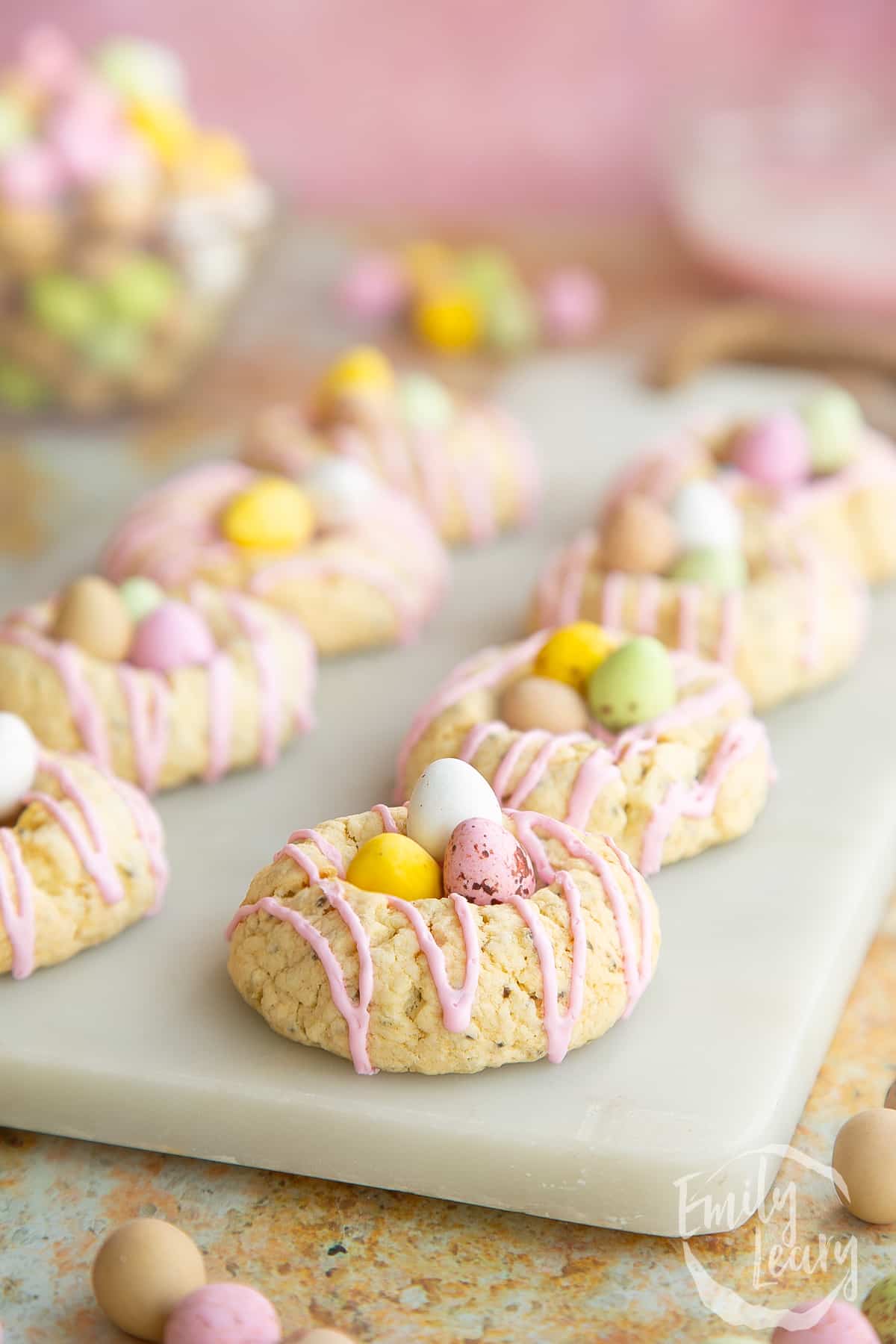
To make these biscuits, you'll start by creaming sugar together with vegan butter, then whisk in soaked chia seeds and vanilla. Fold in the gluten-free flour, baking powder, salt and bicarbonate of soda and your dough is ready.
Once the dough has had a little chill in the fridge to firm up, you'll roll it into balls and arrange on lined baking sheets, pressing a thumb into the centre of each cookie before baking.
To decorate, you'll drizzle a pink icing all over the cookies, then top with mini eggs to create these adorable vegan, gluten-free nests.
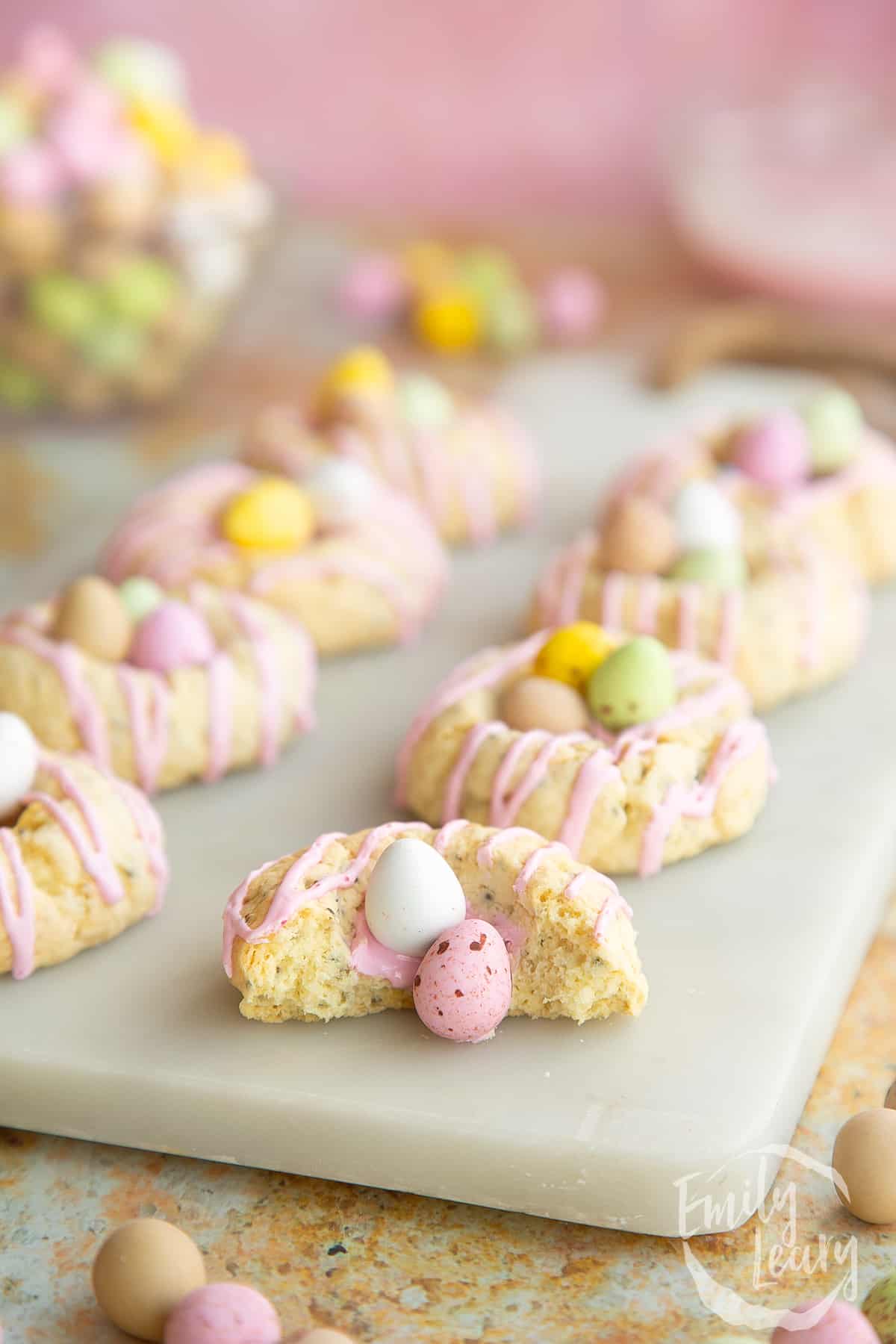
For the mini eggs, you might be able to find what you need in the supermarkets, or you may need to head online to find eggs that suit your dietary requirements. I really like Doisy and Dam Good Eggs. They are made with dark chocolate and don't contain any animal products or any gluten ingredients. However, they do bear a warning that they are "made in a facility that handles milk, gluten, nuts, peanuts and sesame", so they won't be suitable for anyone who strictly needs to avoid traces of those allergens.
Alternatively, D&D Chocolate Eggs don't have the colourful shells, but they are both vegan and gluten free, so would be a great option for this recipe.
Now, let's make these amazing vegan Easter biscuits.
Ingredients
For the cookie dough
- 110 g (1 tbsp) plant-based butter
- 100 g (½ cup + 1 tbsp) white caster sugar (superfine sugar) superfine
- 1 tbsp chia seeds crushed
- ½ tsp vanilla extract
- 250 g (1⅔ cups) plain white flour (all purpose flour) plus extra for dusting
- ¼ tsp bicarbonate of soda (baking soda)
- ¼ tsp baking powder
- ¼ tsp salt
To decorate
- 100 g (¾ cups) icing sugar (powdered sugar) powdered sugar
- 1 tbsp plant milk
- Pink food colouring
- 100 g (3.5 oz) chocolate mini eggs
Instructions
Preheat the oven to 200C (180C fan assisted, 400F).
Line a baking sheet with greaseproof paper
Make the cookie dough
Put the chia seeds in a bowl of water with 2 tbsp water.
Put the vegan butter and sugar in a large mixing bowl.
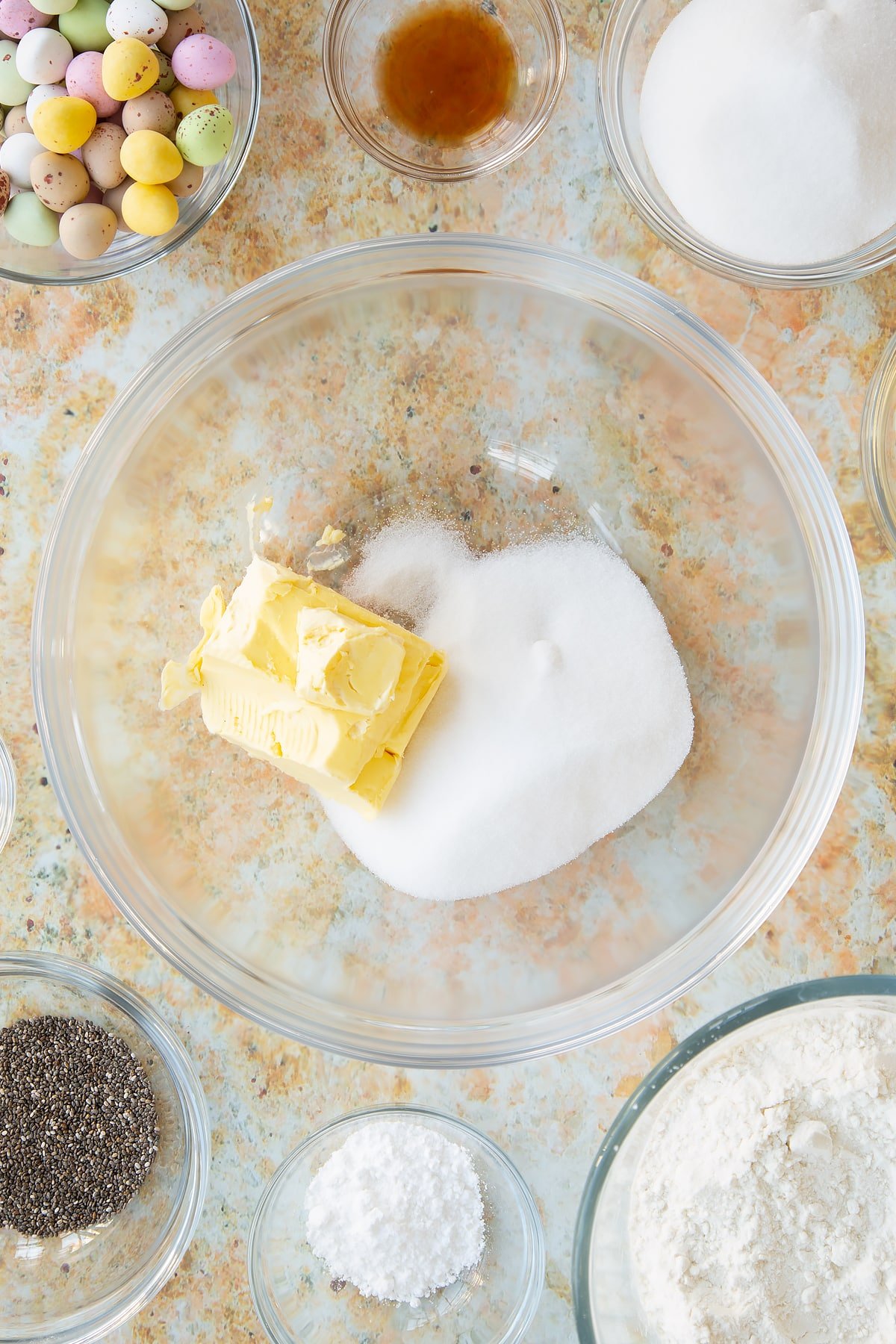
Whisk together until pale and fluffy.
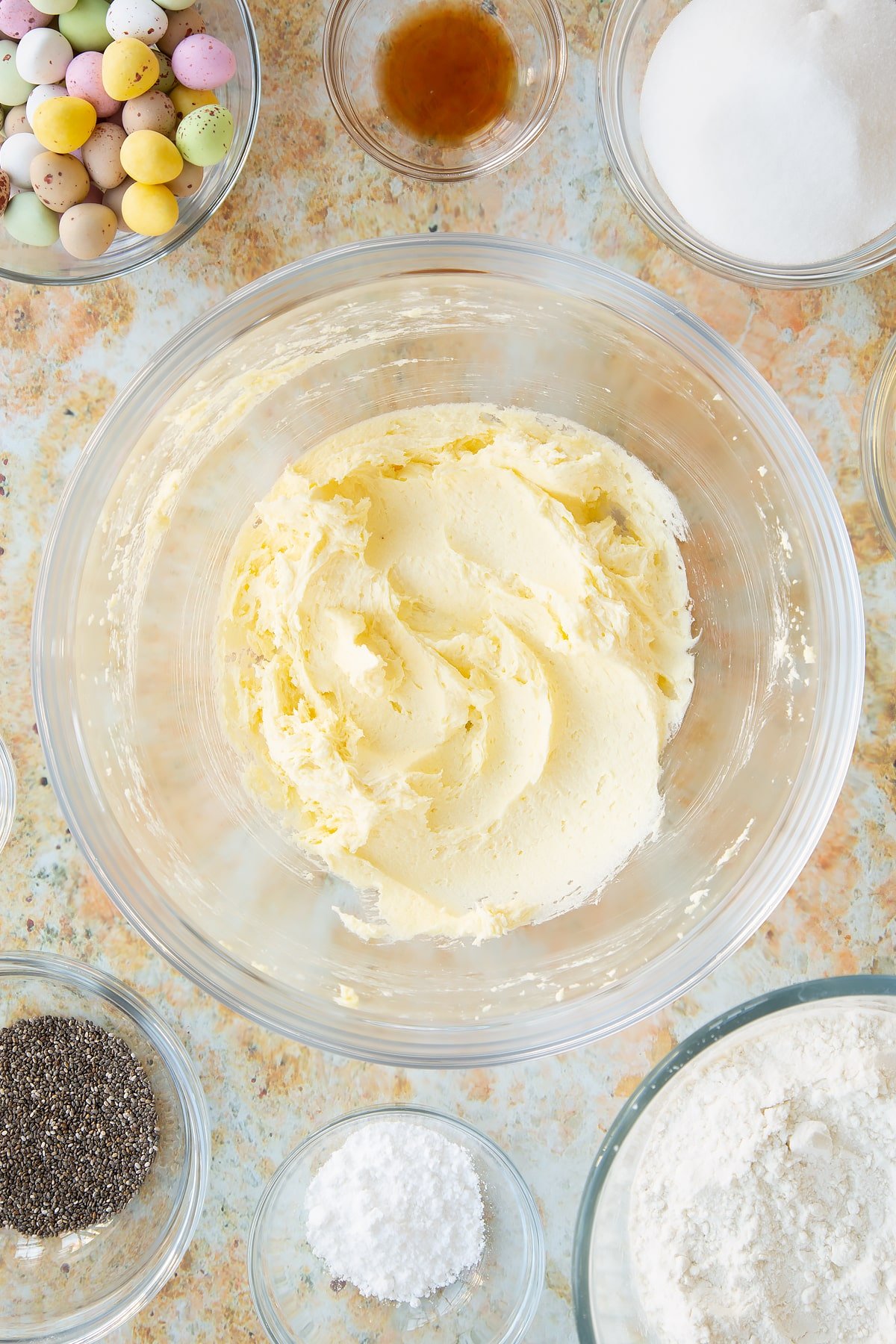
Add the chia seeds and vanilla.
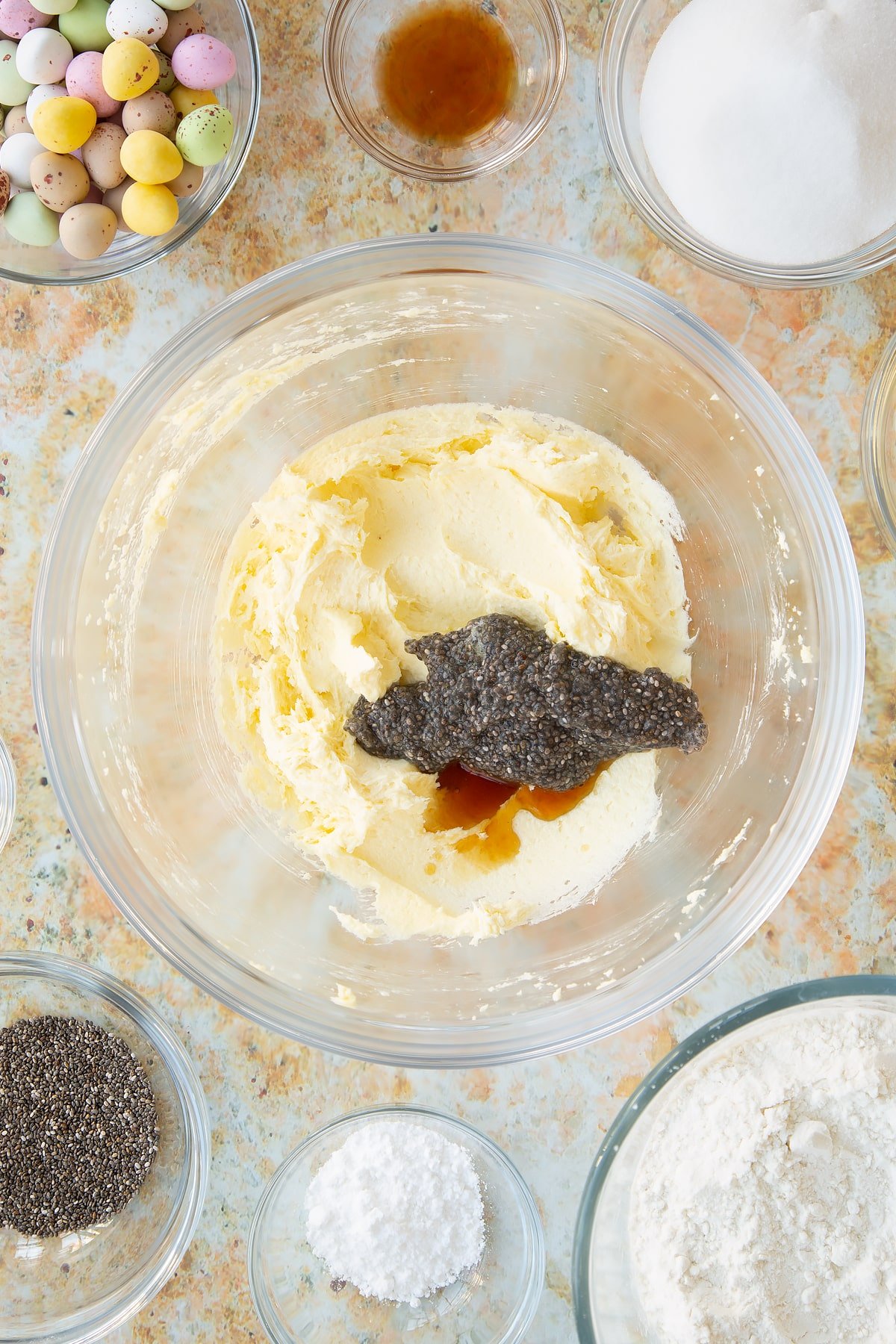
Stir together.
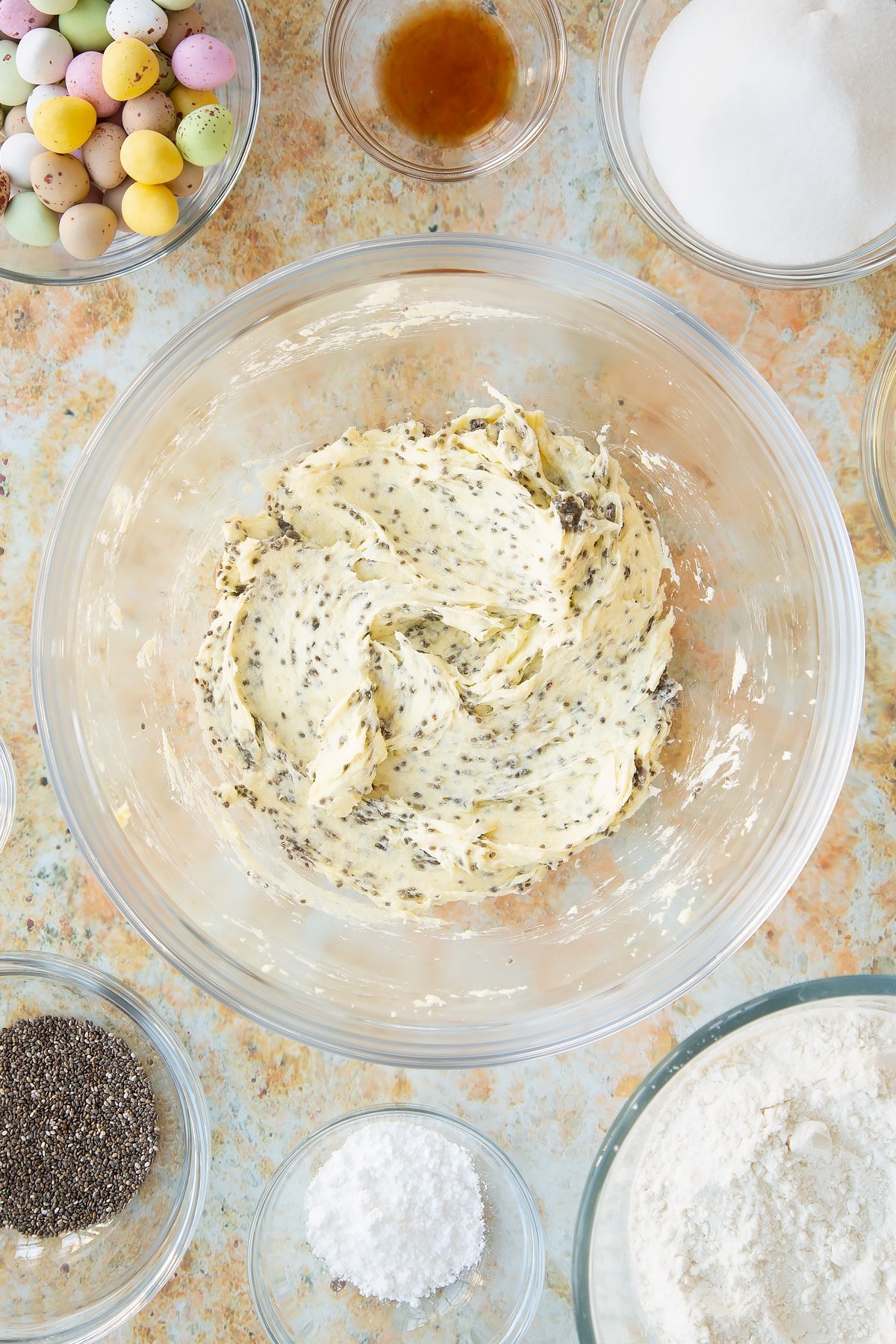
Sift in the gluten free flour, baking powder, salt and bicarbonate of soda.
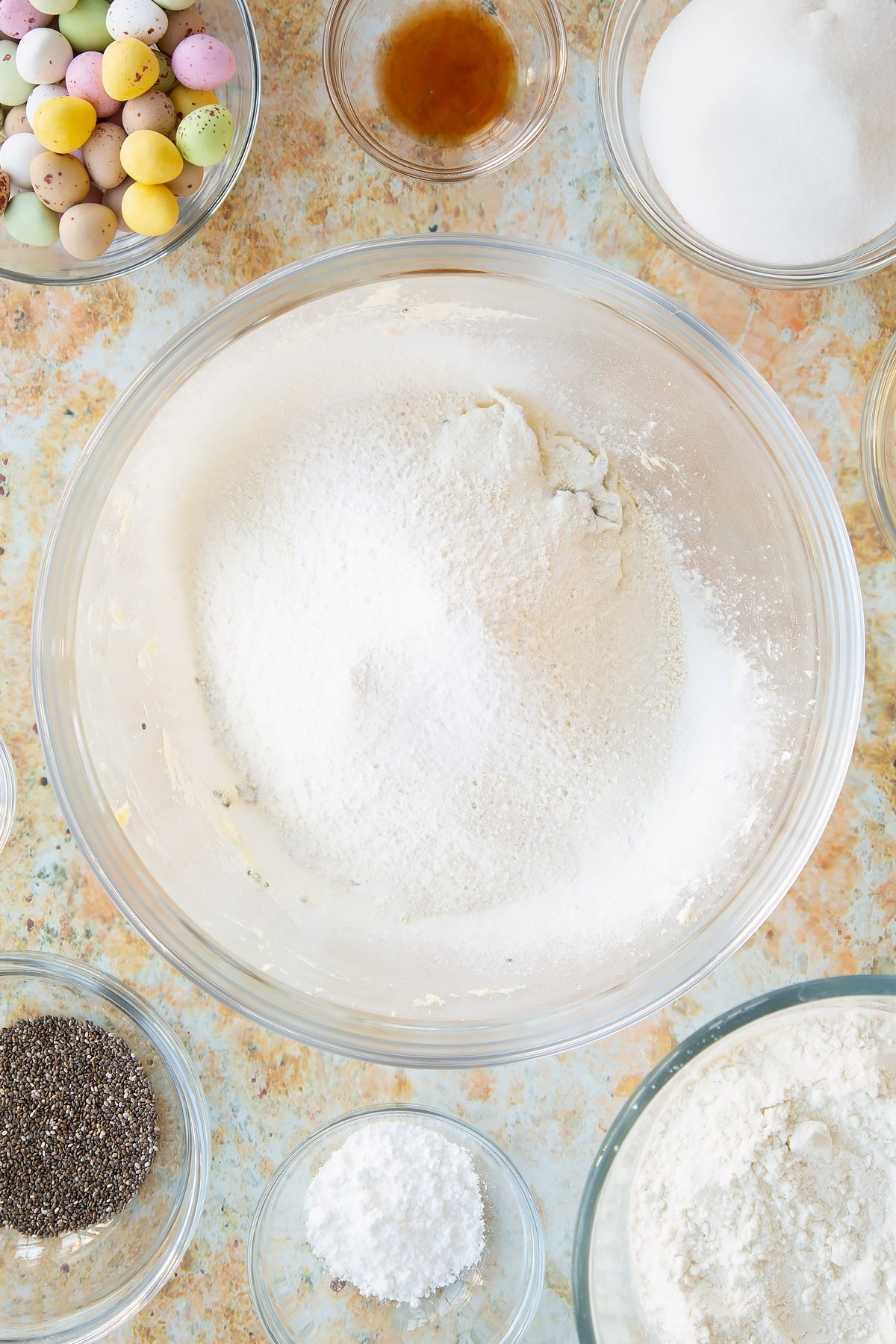
Mix until fully combined.
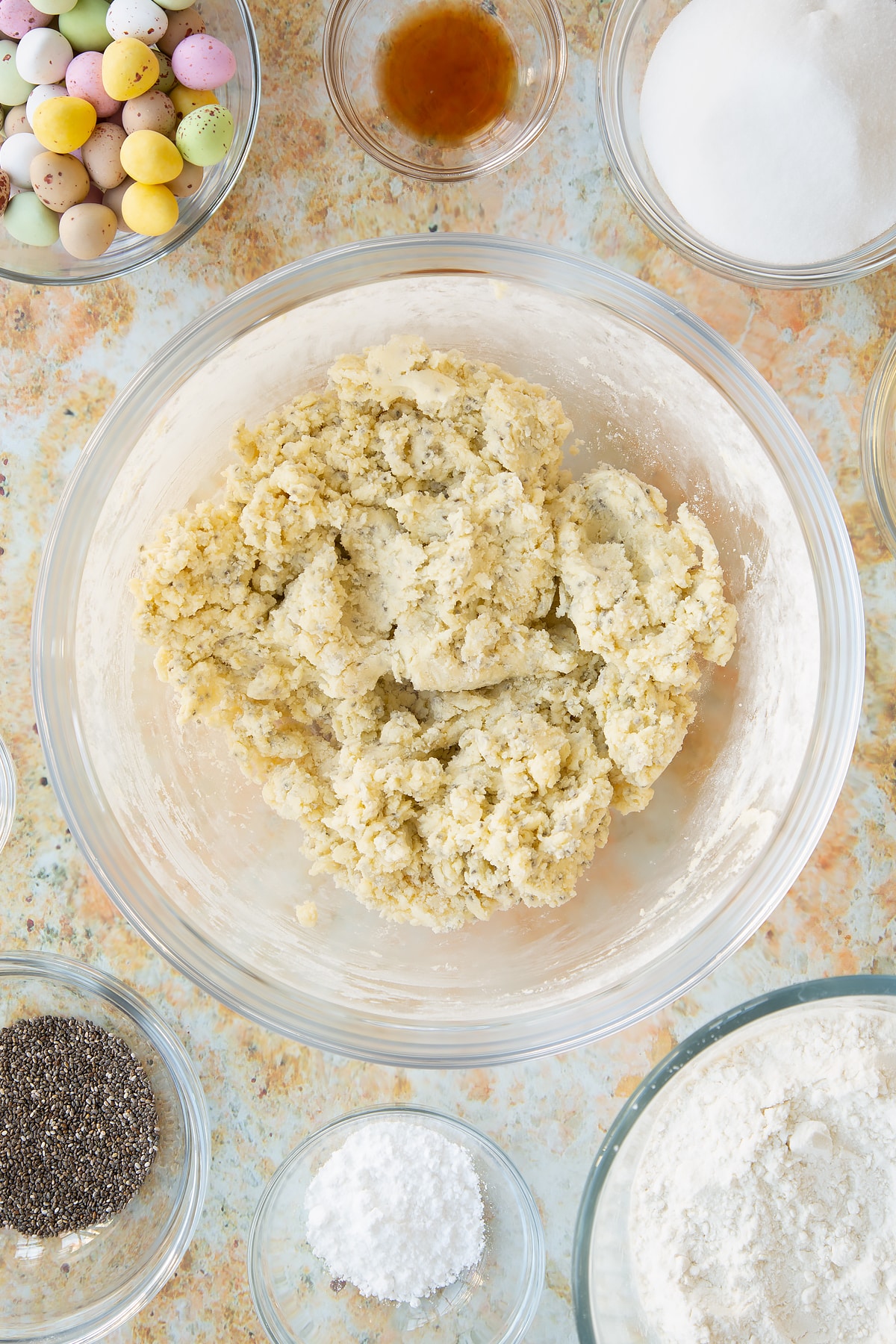
Knead in the bowl only as much as it takes to get a smooth ball of dough.
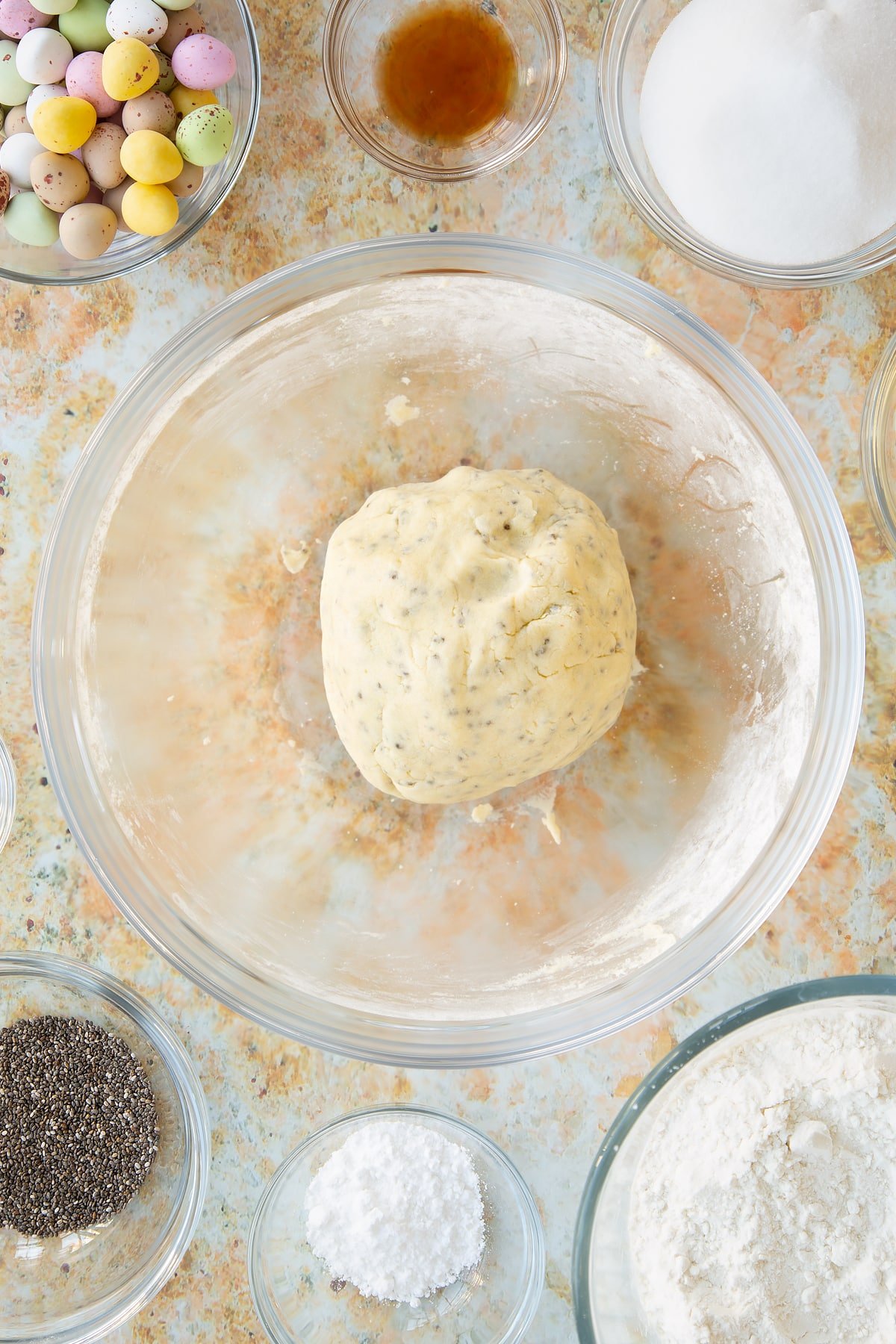
Wrap and place in the refrigerator to firm up. This will take between 15 and 45 minutes depending on how warm your dough got during preparation.
Shape and bake the cookies
Divide the cookie dough into 12 equal pieces. Roll into balls and place, well-spaced, on two lined baking sheets.
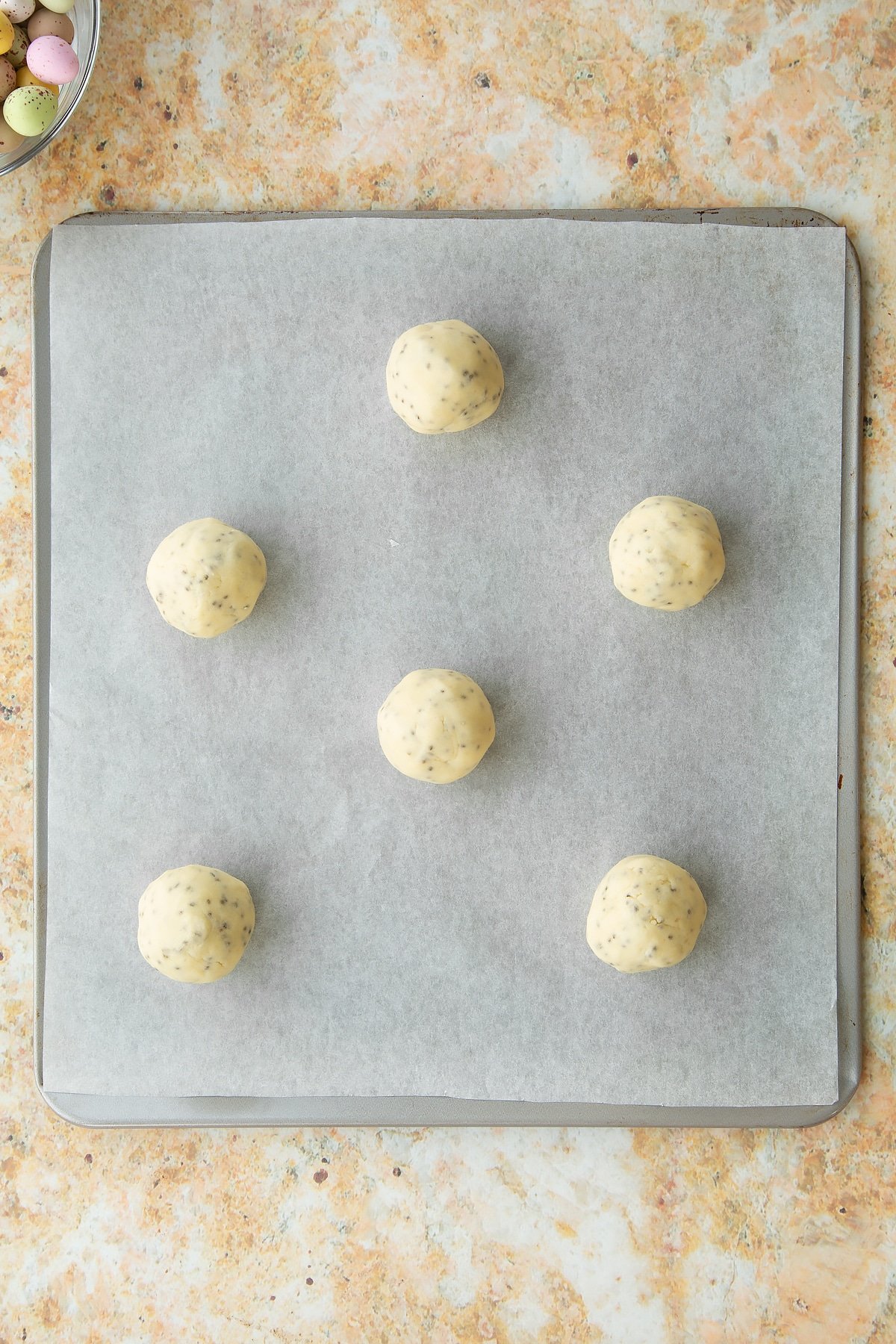
Press your thumb into the centre of each cookie to create a little well.
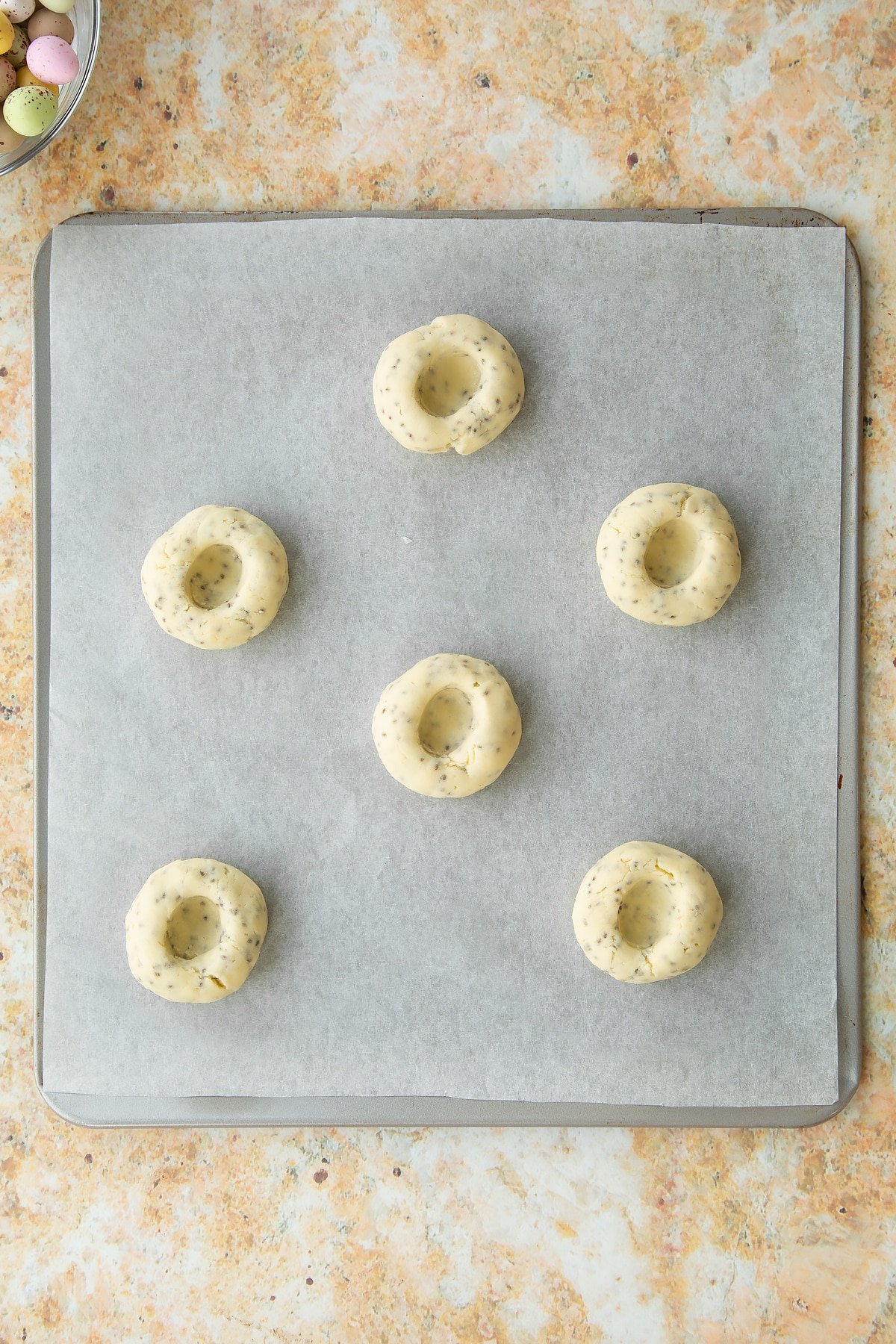
Bake the cookies for 15-20 minutes until they feel fairly firm (they'll crisp up once they're out of the oven)
If the centres have puffed up, you can press them back down gently with the back of a spoon while they're still hot.
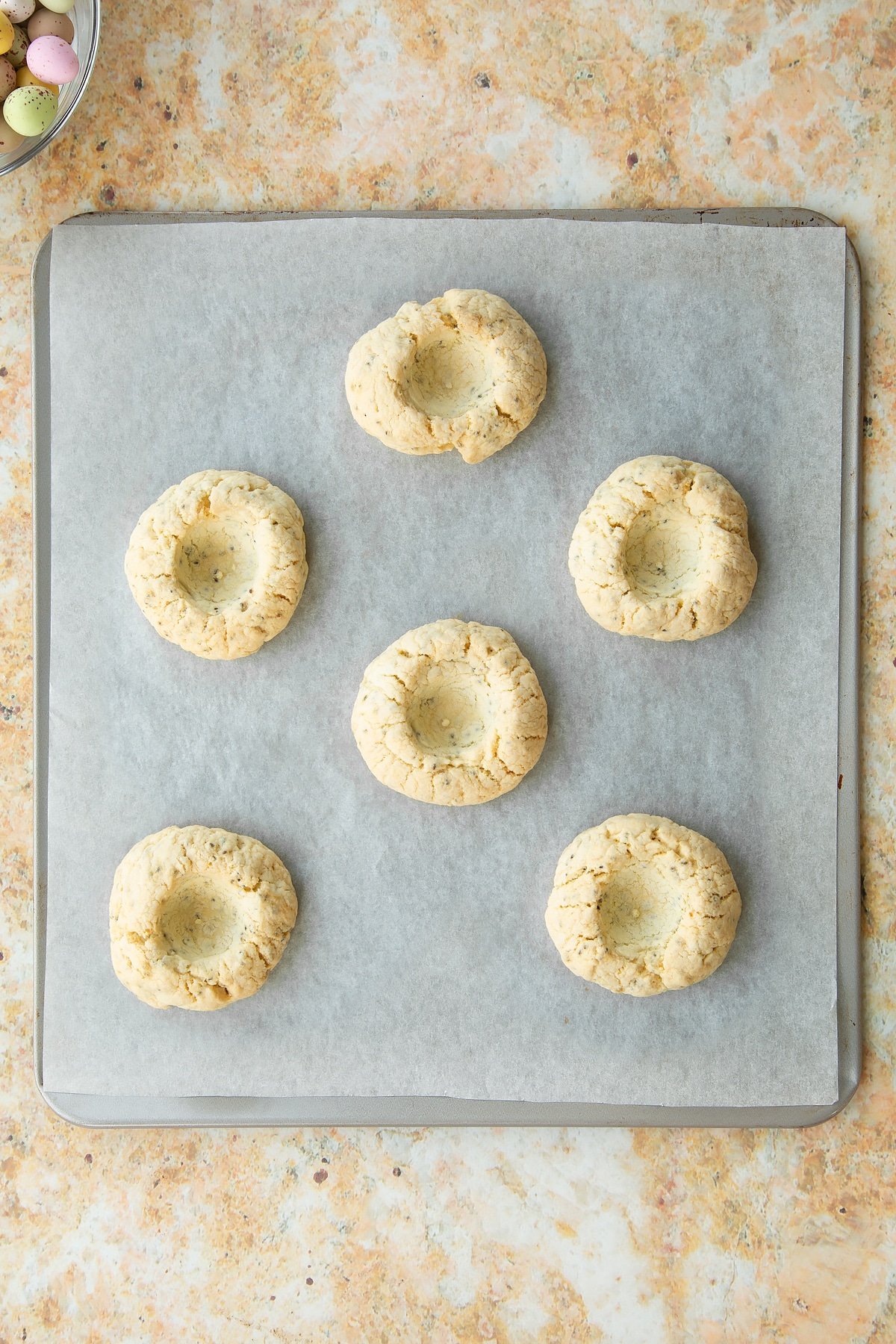
Cool on wire rack.
Decorate the cookies
In a small container, mix the icing sugar with the plant milk and stir together to create a thick icing. Stir in a couple of drops of pink food colouring.
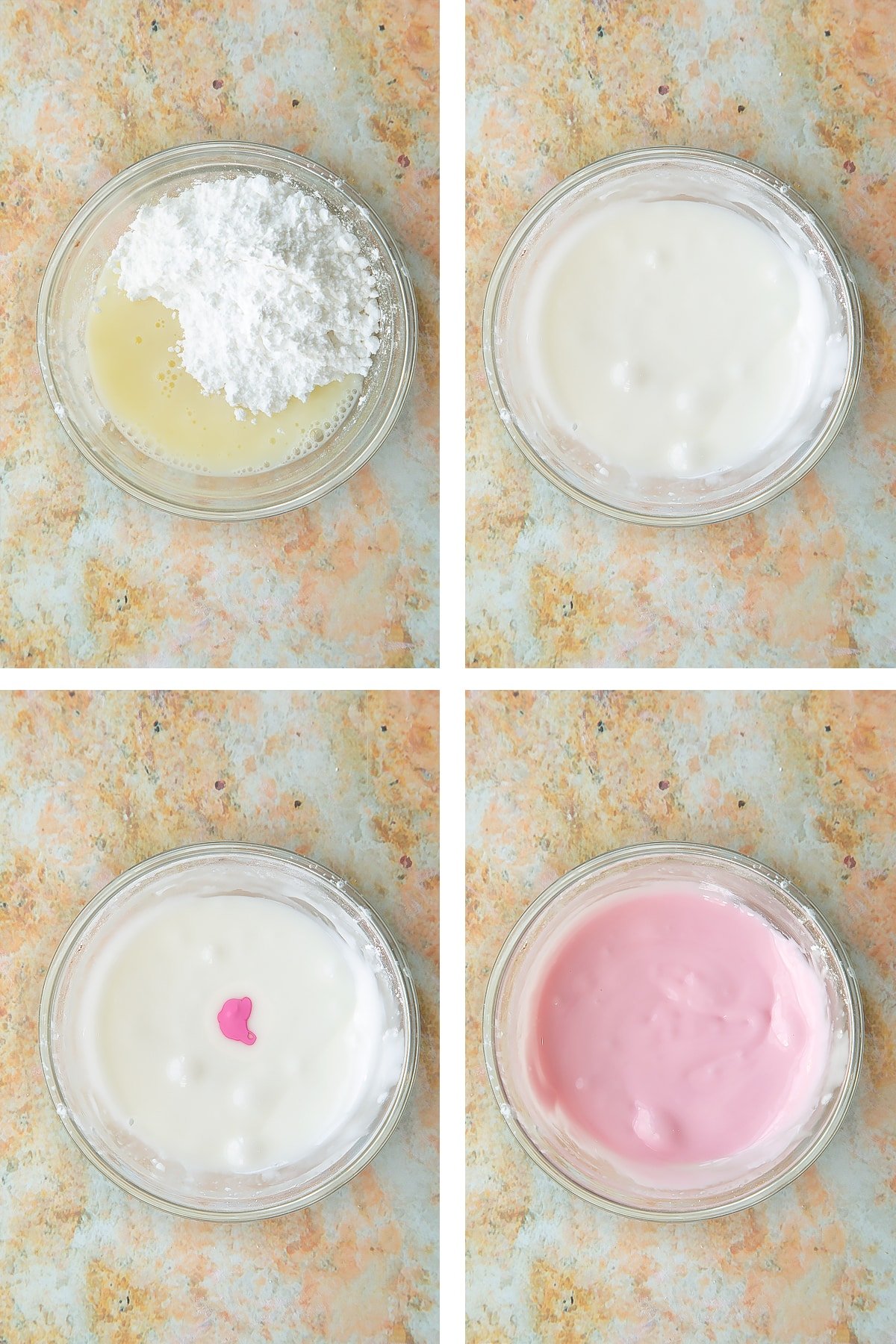
Drizzle the icing over the cookies in a back and forth pattern.
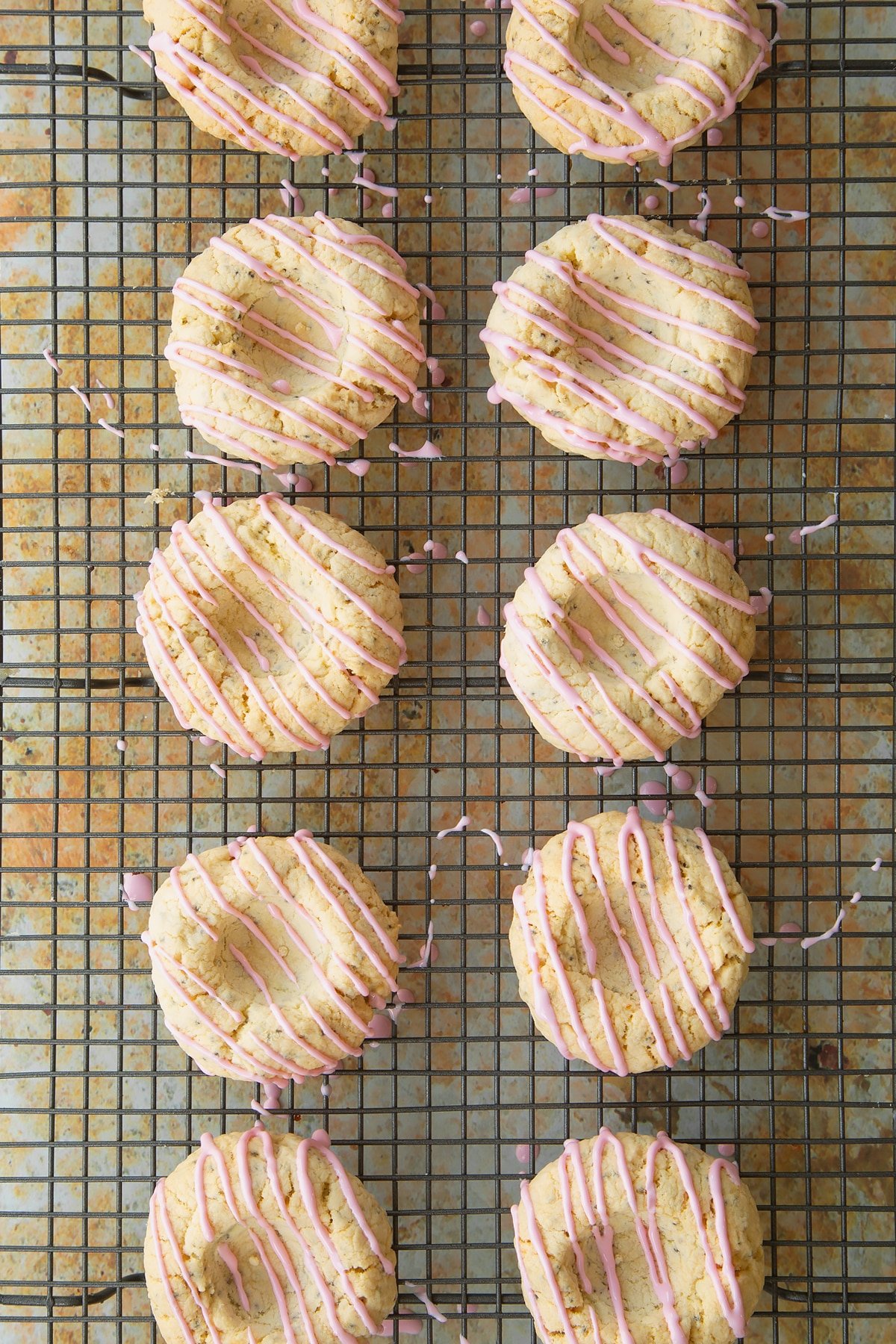
Squeeze a little more of the pink icing into the well in the centre of each cookie.
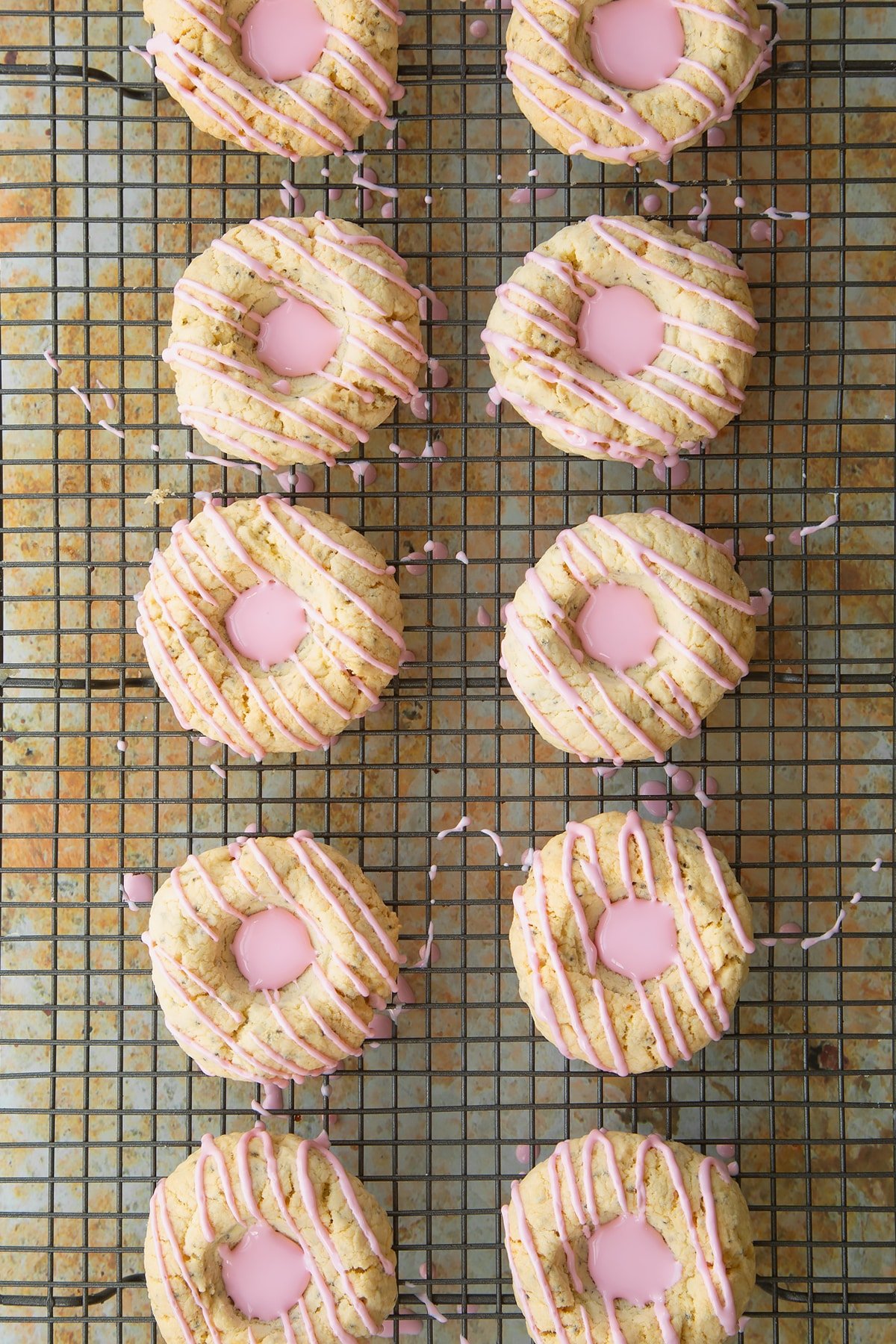
Place three mini eggs in each well to complete the little nests.
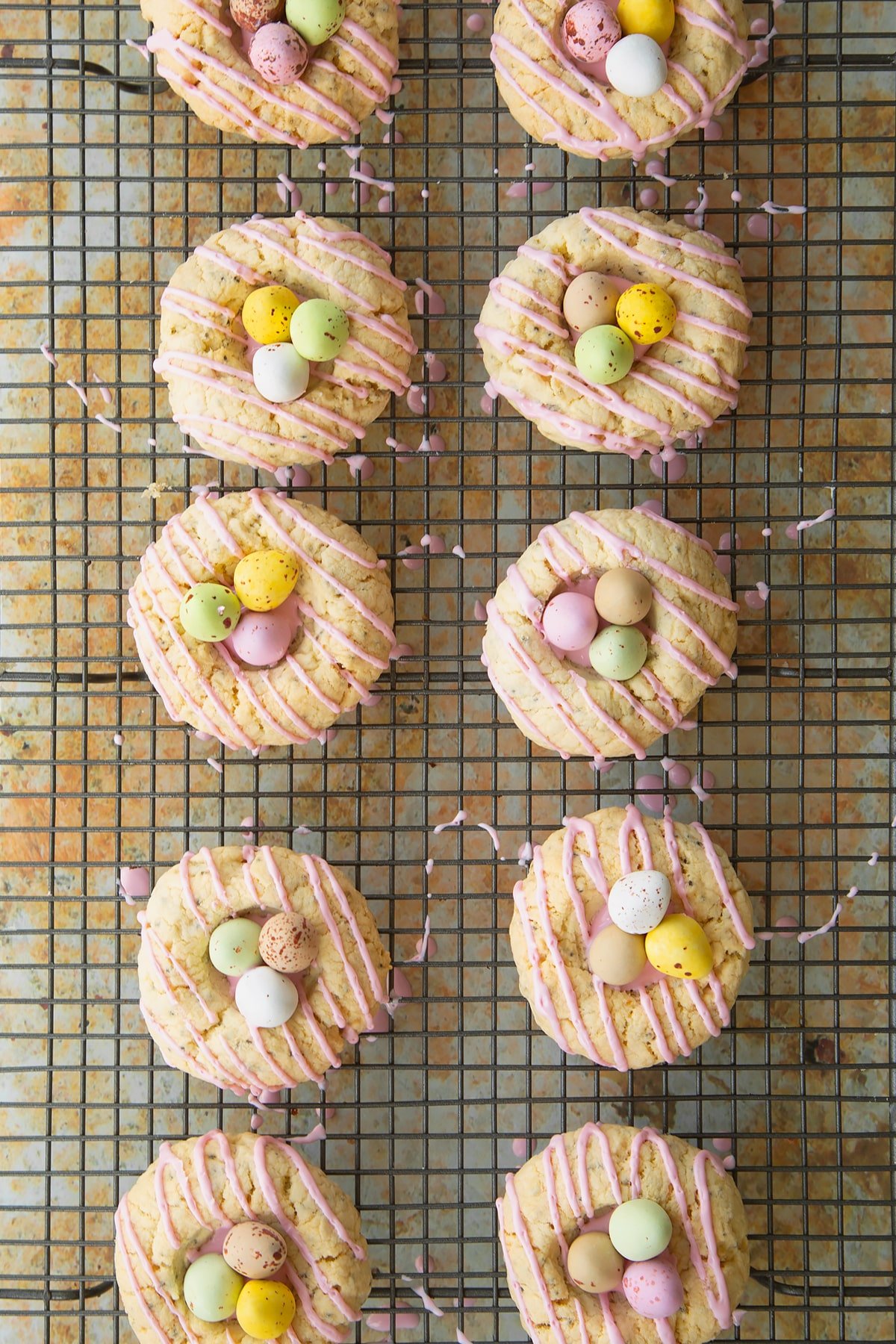
Enjoy these beautiful little gluten-free, vegan Easter biscuits.
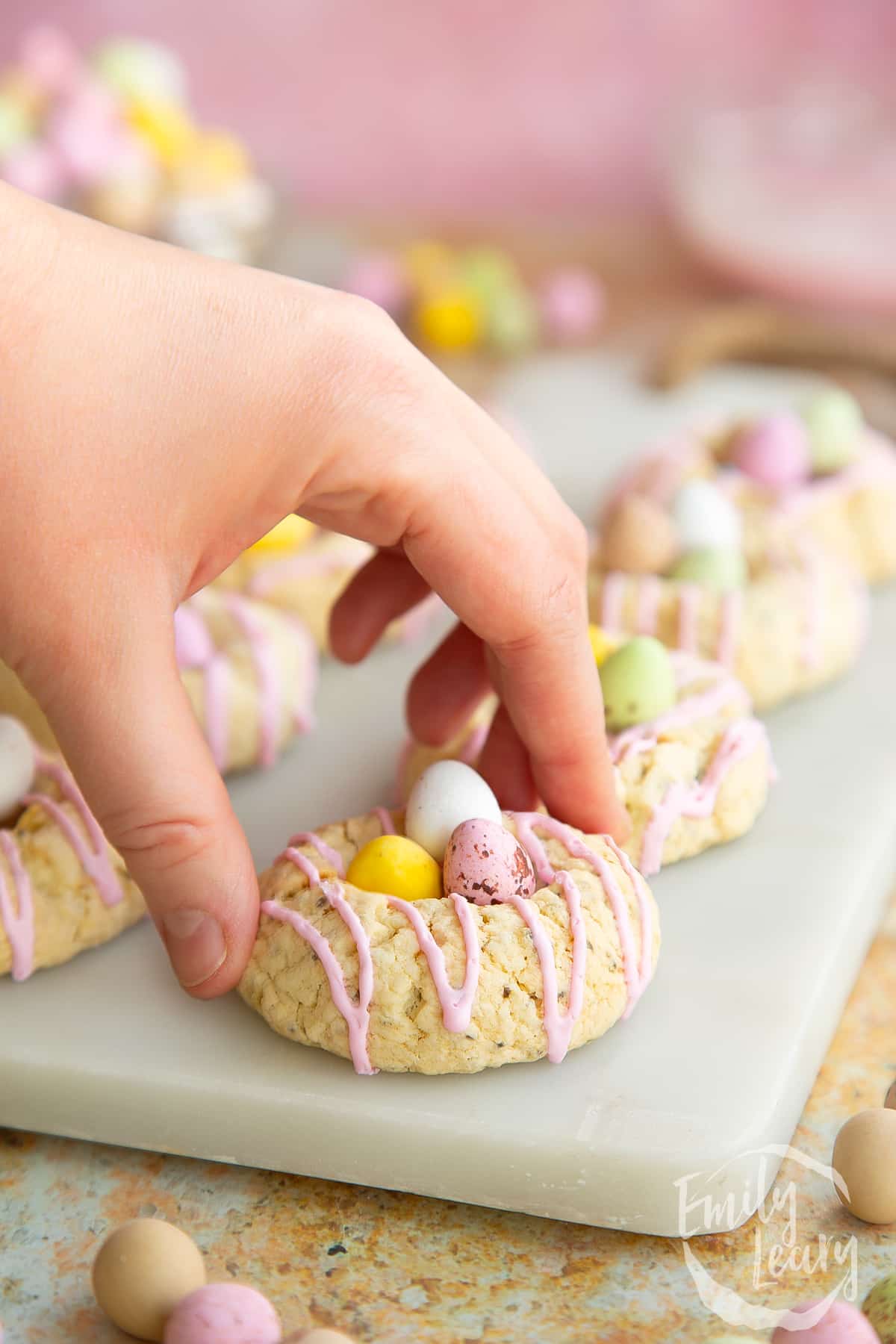
Pointers, tricks and troubleshooting tips for the perfect Vegan Easter biscuits recipe
Is this Vegan Easter biscuits recipe easy to make?
This Vegan Easter biscuits recipe is a really easy way to get something on the table for the people who are usually an afterthought - vegans and gluten-intolerant.
Will I need any special equipment to make this Vegan Easter biscuits recipe?
You’ll only need some everyday kitchen equipment for this recipe. You’ll need some scales and measuring spoons to measure your ingredients. The biscuit is mixed in just one bowl with a whisk/spoon, then shaped by hand and placed onto a baking tray. Then to cook, you’ll need a baking tray lined with baking paper and then you can use a wire rack to cool your biscuits.
If you’re in doubt, there’s always a full list of suggested equipment on the recipe card below my recipes. I always include links to example products, so you can see exactly what I used to make each recipe.
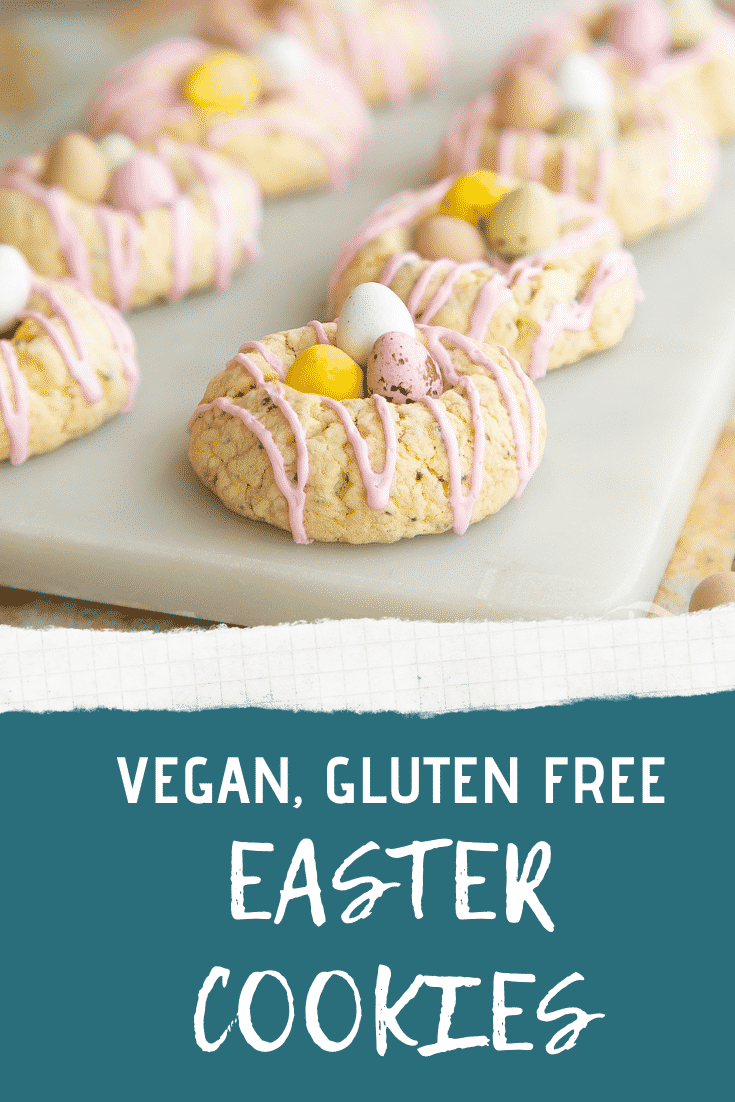
Is this Vegan Easter biscuits recipe suitable for vegetarians?
Yes, this recipe is completely vegan, so it contains no animal products - which means it’s also suitable for veggie friends!
Always make sure that you double-check your ingredients labels to ensure that they’re vegetarian. Also, don't forget to check anything extra that you intend to serve with your recipe.
Is this Vegan Easter biscuits recipe suitable for vegans?
Yep, the clue is in the name! These Vegan Easter biscuits are completely vegan. So they would make the perfect gift for any plant-based pals!
However, don't forget to check anything extra that you intend to serve with your recipe.
Is this Vegan Easter biscuits recipe gluten-free?
This might be the perfect Easter biscuit recipe, because not only is it vegan, but it’s also gluten-free! So it’s safe for your gluten-free friends to enjoy without stress!
Double check all of your ingredients labels to make sure that they are gluten-free. Don't forget to check anything extra that you intend to serve the recipe with.
Is this Vegan Easter biscuits recipe keto-friendly?
Unfortunately this recipe isn’t keto-friendly, as it contains carbohydrates and sugar. A ketogenic diet limits you to less than 50g carbohydrates per day to control your blood sugar levels and encourage your body to burn fat. So one of these Vegan Easter biscuits would take up a large amount of your daily carbohydrate allowance.
Is this Vegan Easter biscuits recipe healthy?
This Vegan Easter biscuit recipe contains sugar and vegan chocolate, so it’s not the healthiest snack. Many people assume vegan food is automatically healthy, but that’s often not the case.
However, there’s nothing wrong with enjoying these biscuits as a treat! If you’re vegan you’re most likely eating a more varied and vegetable filled diet, so there’s nothing wrong with including a treat in there too!
Is this Vegan Easter biscuits recipe safe to eat while pregnant?
This recipe is egg and dairy free, so most of the common food risks for a pregnancy aren’t involved in this recipe. So as long as all of your ingredients are in good condition and this meal is prepared safely and hygienically, it would make a perfect treat for a pregnant pal!
A Mummy Too does not offer medical advice. Please seek help from a medical professional if you need further information or have any concerns.
What type of plant milk should I use for this Vegan Easter biscuits recipe?
I used soya milk to make these Vegan Easter biscuits, but feel free to use your favourite plant-based milk. There are so many plant-based kinds of milk available in supermarkets now, and most of them behave in the same way when cooked.
Unsweetened soy milk and oat milk are the best for cooking, as they have the most neutral flavour and are stable in cooking. Though almond, coconut and rice milk are also very popular, feel free to try them!
What are chia seeds?
Chia seeds are small, flavourless seeds from a South American plant, and you can use them in various ways to thicken food or drinks. So you can use them in sweet or savoury dishes without impacting the flavour. And if you grind them into a powder the texture won’t be affected either.
Chia seeds are considered a superfood as they’re so rich in vitamins, minerals and fibre. So they’re a really beneficial ingredient for plant-based diets. Chia seeds are so nutritious they were even considered a source of power for warriors in ancient Mayan and Aztec civilizations.
When you add chia seeds to liquid, the porous shell starts to absorb water and release a gel membrane. The texture is similar to egg whites, which is why they’re a great egg replacer.
Where can I buy chia seeds?
Chia seeds have been a staple food in many South American countries for centuries and since the 2000s they’ve become a common ingredient in Europe. So they’re pretty easy to find in most supermarkets or health food stores.
You’ll most likely find chia seeds with the dried nuts and seeds in your local supermarket, or sometimes they’re kept on the baking aisle. Chia seeds are often very affordable, and they usually cost less than £5 for 200g. If you don’t live near a larger supermarket, you can also buy them online from Amazon, Whole Foods, or health food stores.
Do I need to crush my chia seeds?
Chia seeds are tiny and break easily, so it won't affect the texture of your biscuits if you don't crush them.
However, if you use flax seeds you’ll need to crush them so that they absorb water, as they have a thicker shell than chia seeds.
If you don't want whole chia seeds, then you can crush them down. Chia seeds are similar in size and texture to mustard seeds, so you can use a pestle and mortar or use a blender to break them down.
I can’t find chia seeds. What can I use instead of chia seeds?
Flax seeds are another seed which can be used as an egg replacer. So if you can’t find any chia seeds in-store or online, you could replace the chia seeds with the same amount of ground flax seeds.
Flax seeds have a thicker, elongated shell, so they need to be crushed down to enable them to react with water. You can crush them in a pestle and mortar or a power blender.
You will usually find flax seeds with chia seeds on the baking aisle. Sometimes you’ll even find ‘milled flax seeds’ which are pre-ground so that you can use them straight away. Flax seed is sometimes called ‘Linseed’, so look out for that if you don’t see any chia or flax.
How should I store my Vegan Easter biscuits?
The best way to store your Vegan Easter biscuits is to place them into an airtight container like a lunchbox. I find it best to layer the biscuits between sheets of parchment to protect the decoration from getting damaged.
You should keep the container in a cool dark place, like a cupboard or a pantry. There’s no need to refrigerate your biscuits. Refrigerated baked goods can often end up soggy due to the way moisture behaves in a fridge.
How long will these Vegan Easter biscuits keep?
Your Vegan Easter biscuits should keep for up to 5 days if you store them correctly. Or you can keep them for 2-3 months in the freezer.
Can I leave these Vegan Easter biscuits out on the counter?
You can leave your Vegan Easter biscuits on the counter to serve them, but once you’re done you should keep them in a container.
The biscuits will go stale after a few hours out on the counter. So to keep them fresh for longer, store them correctly.
Can I make these Vegan Easter biscuits ahead?
Sure! You could make these biscuits a couple of days ahead and keep them in a container before serving. Though they’ll be at their best on the day you make them.
You can also make the dough ahead of time and freeze it for up to 2 months. Then all you need to do is defrost the dough the night before and follow the instructions from step 7 onwards.
Can I keep these Vegan Easter biscuits in the refrigerator?
You can, but I prefer to keep my bakes in a container in the cupboard. Sometimes baked goods can become soggy, as refrigeration causes moisture to behave differently and absorb into baked goods.
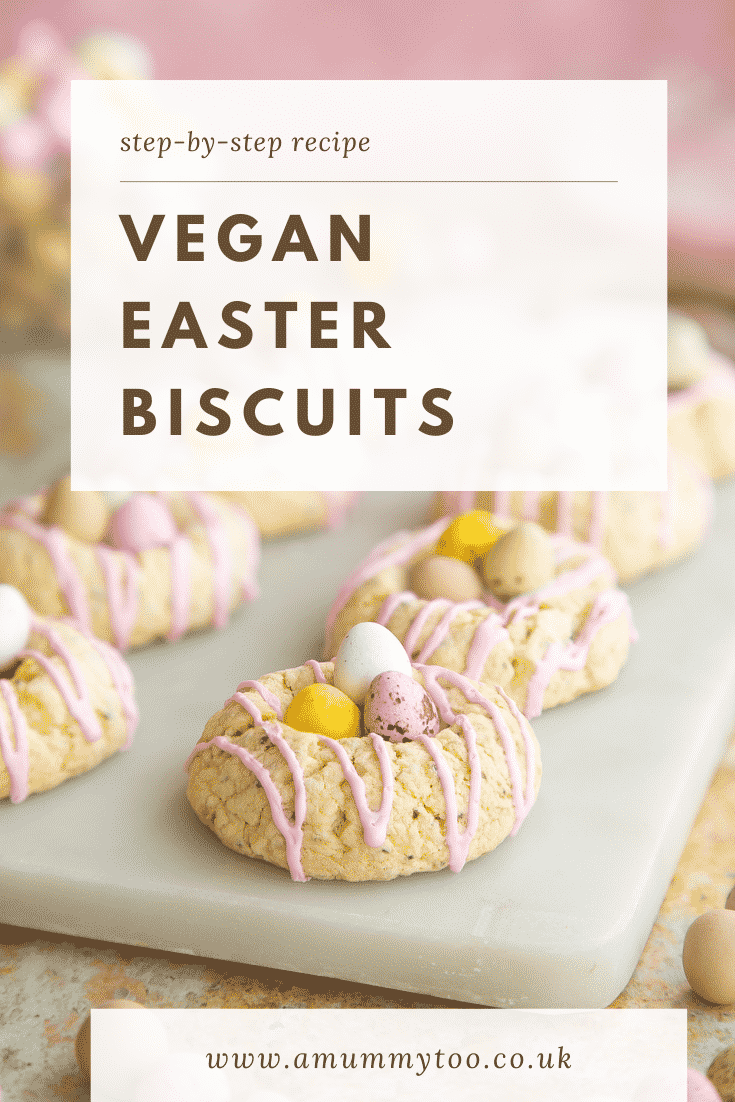
Can I freeze Vegan Easter biscuits?
Yes, these biscuits will freeze really well. However, it’s best to freeze them without the decorations, as the eggs can break or look scruffy as they defrost.
What is the best way to defrost my Vegan Easter biscuits?
The best way to defrost your Vegan Easter biscuits is to transfer the container of biscuits or dough from the freezer into the fridge and leave it overnight before serving or making. Then when you want to serve your biscuits you can let them come to room temperature.
Or if you're only defrosting one biscuit, just leave it on a plate on the counter for around 45 minutes.
Can I make this Vegan Easter biscuits recipe in a different quantity?
If you want to make more or less of this recipe then go right ahead! These biscuits cook individually, so you won’t need to adjust the cooking time or temperature.
I find it best to manually work out the recipe portion by dividing the current recipe by the serving size to get a one portion size. Then you can multiply that amount to the new amount you want to make.
Can I use a stand mixer like a KitchenAid or Kenwood Mixer to make this Vegan Easter biscuits recipe?
You could use a stand mixer to cream together the vegan butter and sugar on a low to medium speed. Then you can gradually add the remaining ingredients while mixing at a slow speed. Remember to scrape down the sides of the bowl so you don’t miss any of the ingredients!
Chia seeds have a tendency to cling to the bowl, so watch out for that.
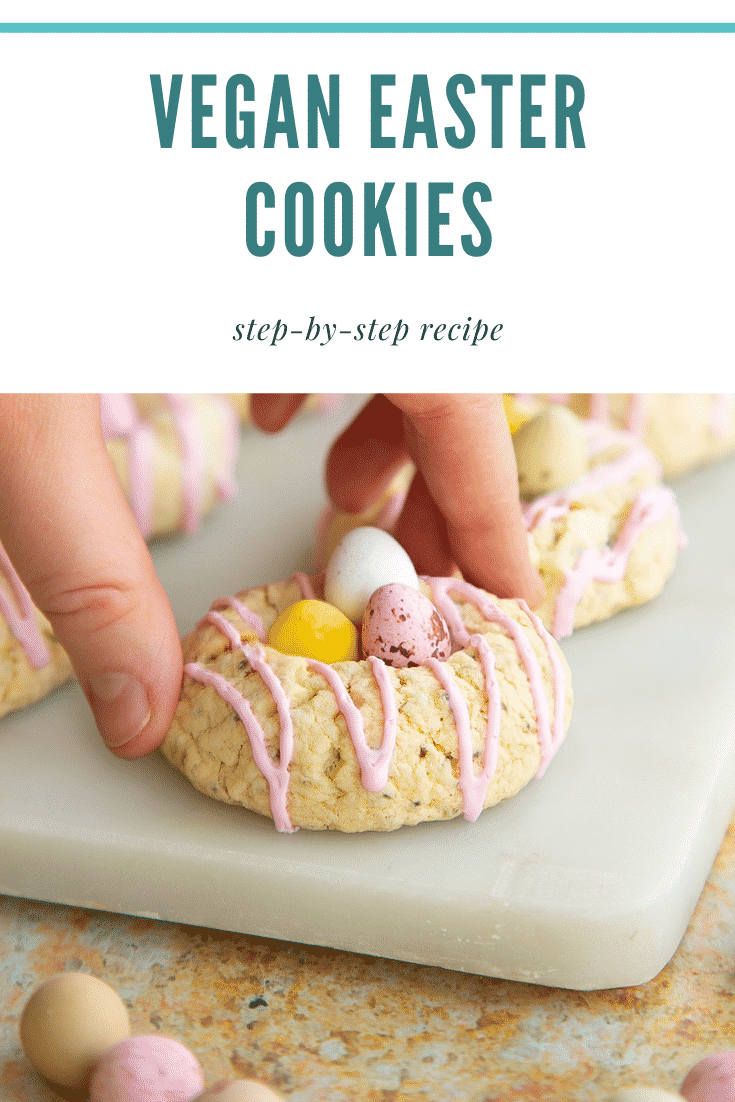
Can I use a food processor to make this Vegan Easter biscuits recipe?
A food processor would be much too powerful for this recipe. You would end up with a paste like dough and it would poorly affect the quality of your Vegan Easter biscuits. So it’s best to mix by hand, or if you need some mixing help it’s better to use a stand mixer.
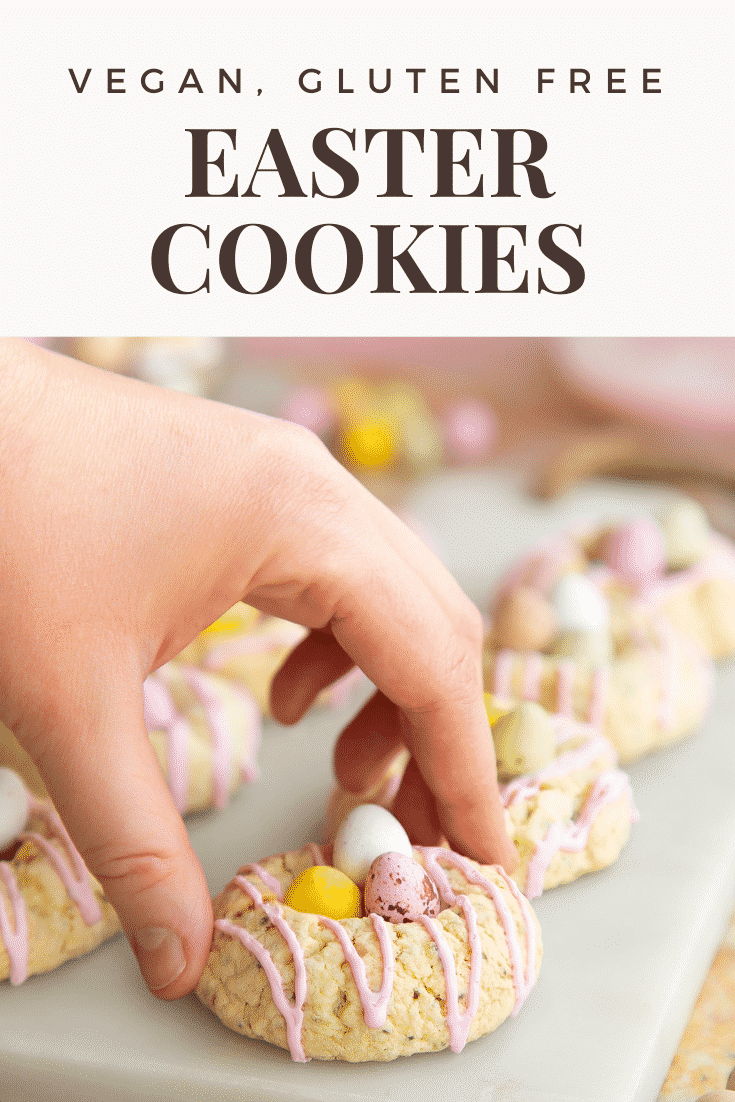
Where can I buy food colouring? What kind should I buy?
For this recipe, I used a couple of drops of liquid food colouring. Liquid food colouring is very easy to use and easy to find. It’s usually sold on the baking aisle of your local supermarket or even a corner shop. However, you can usually find a wider range of colours on Amazon or specialist baking online retailers.
The quality can vary depending on the brand, so you should use a good quality brand rather than a cheaper generic kind. Progel is an example available in the UK. It’s an affordable brand and it has a wide range of colours.
You should always make sure that you use food colouring, which is in date, as it might dry out, become unsafe to eat or unstable over time. If your food colour looks thicker or dry, or has leaked, it’s safer to discard it and buy a fresh bottle.
How can I make sure my Vegan Easter biscuits recipe turns out perfectly?
To get perfect Vegan Easter biscuits every time, it’s important to follow the recipe exactly as directed. While there are less volatile ingredients making it more forgiving than a non-vegan recipe, there are still a few points to watch. So here are some common pain points to watch out for when baking this recipe:
- Measure out ingredients: It’s important to make sure that your ingredients are measured out into the correct portions before you begin cooking. Otherwise you might make mistakes while multitasking and measuring. Having your ingredients ready before you begin also helps you avoid forgetting any ingredients too.
- Check your spoon measurements: Another point to watch out for when measuring your ingredients is the spoon measurements. There are several tablespoon and teaspoon measurements in this recipe - so make sure you don’t mix them up!
- Preheat the oven: If you put your Vegan Easter biscuits into an oven which is too cool or too hot, they won’t cook properly. So make sure your oven is up to temperature and not too hot.
- Soak your chia seeds: Soaking your chia seeds helps them behave more like an egg, so make sure you let them soak for 10 minutes before you add them to the recipe. Otherwise they will just suck up too much moisture from the wet ingredients and leave you with dry biscuits.
- Let the dough rest and firm up: The dough needs to rest and firm up for at least 15 minutes in the fridge. If you skip this step you will most likely end up with flat, spread out biscuits.
- Don’t squash the dough balls too much: Another cause of flat, spread biscuits is pushing them down too hard. So make sure you only lightly press them into the right shape with your thumb.
- Let the biscuits cool before decorating: If you put your icing onto the biscuits while they’re still warm, the icing will run and look scruffy. So let your biscuits cool on a rack for at least 20 minutes before decorating them.
Why did my Vegan Easter biscuits recipe turn out dry/crumbly?
If your Vegan Easter biscuits are dry and crumbly, then it’s most likely to do with the chia seeds.
Chia seeds are like water magnets, and they can hold 10 times their size in liquid. So if you skip the chia seed soaking stage, your chia seeds will absorb extra water from the wet ingredients in the biscuit mixture, causing dry, crumbly biscuits,
Alternatively, your biscuits may just be overcooked. This can happen if your oven is too hot, or you cooked the biscuits for too long.
If you find your bakes often overcook, it may mean that your oven temperature is hotter than the dial states. An oven thermometer is a good way to work around an incorrect oven temperature, as it gives you an accurate reading of the internal temperature of the oven.
You can buy oven thermometers from Amazon, but they’re also available in the kitchenware department of homeware stores.
Why did my Vegan Easter biscuits recipe turn out wet/soft?
If your Vegan Easter biscuits are wet and dense, then it sounds like there’s too much liquid in the dough or they’re undercooked.
Your biscuits may be a little soft when they first come out of the oven, but they should harden as they cool. However, if they’re very soft you could cook them for an extra 5 minutes to see if that helps.
If this still doesn’t work, and your biscuits are very wet and sloppy, there’s something wrong with the ratio of ingredients in the biscuit mix. If you try the recipe again, I’d recommend measuring out your ingredients before you begin cooking. Also, make sure that you don’t mix up the spoon measurements (tbsp = tablespoon, tsp = teaspoon).
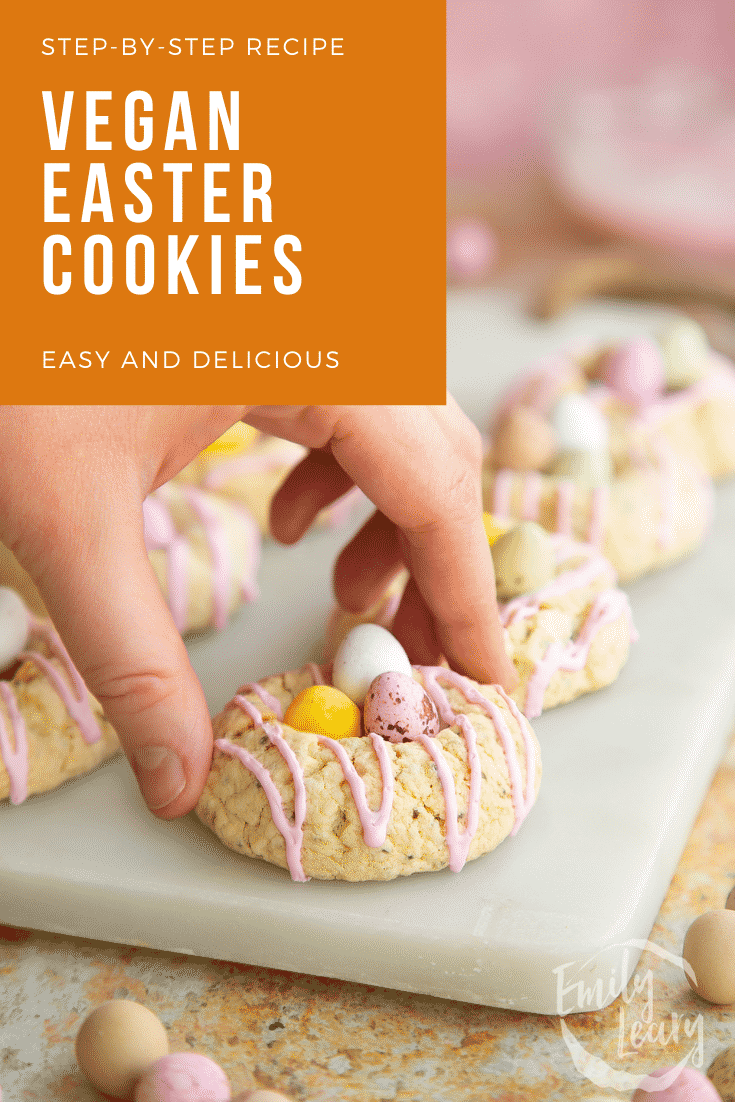
Why didn’t my Vegan Easter biscuits recipe rise?
If your biscuits didn’t rise, then it could be because the raising agents were old or the oven wasn’t warm enough to activate the chemical reaction.
If your cookies turn out very flat and wide, the oven temperature is too low. This causes the cookie dough to melt and spread out before it can cook and set in a cookie shape. So if your oven seemed cool when you put the biscuits in, then that’s the issue. Preheating your oven and using an oven thermometer will help avoid this issue in the future.
But if your oven was at the correct temperature then it’s most likely that the raising agents failed. This can happen if you use baking powder/bicarbonate of soda which hasn’t been stored correctly. So make sure that you use raising agents which have been stored in an airtight container and are within the use by date for best results.
How can I add/change the flavours in these Vegan Easter biscuits?
These Vegan Easter biscuits are the perfect canvas for you to customise, as they’re lightly flavoured with vanilla. So feel free to add any other food essence you prefer, as the dough should be quite forgiving and allow for an extra teaspoon of liquid. Or you could use lemon or orange zest to flavour the dough too.
Whichever extra flavours your choose to include, make sure that you use vegan and gluten-free ingredients so this recipe remains suitable for those avoiding animal products and gluten.
Print this vegan easter biscuits recipe
Vegan Easter Biscuits Recipe (Gluten Free)
Ingredients
For the cookie dough
- 110 g (1 tbsp) plant-based butter
- 100 g (½ cup + 1 tbsp) white caster sugar (superfine sugar) superfine
- 1 tbsp chia seeds crushed
- ½ tsp vanilla extract
- 250 g (1⅔ cups) plain white flour (all purpose flour) plus extra for dusting
- ¼ tsp bicarbonate of soda (baking soda)
- ¼ tsp baking powder
- ¼ tsp salt
To decorate
- 100 g (¾ cups) icing sugar (powdered sugar) powdered sugar
- 1 tbsp plant milk
- Pink food colouring
- 100 g (3.5 oz) chocolate mini eggs
Instructions
- Preheat the oven to 200C (180C fan assisted, 400F).
- Line a baking sheet with greaseproof paper
Make the cookie dough
- Put the chia seeds in a bowl of water with 2 tbsp water.
- Put the vegan butter and sugar in a large mixing bowl and whisk together until pale and fluffy.
- Add the chia seeds and vanilla and stir together.
- Sift in the gluten-free flour, baking powder, salt and bicarbonate of soda, then mix until fully combined.
- Knead in the bowl only as much as it takes to get a smooth ball of dough.
- Wrap and place in the refrigerator to firm up. This will take between 15 and 45 minutes depending on how warm your dough got during preparation.
- Shape and bake the cookies
- Divide the cookie dough into 12 equal pieces. Roll into balls and place, well-spaced, on two lined baking sheets.
- Press your thumb into the centre of each cookie to create a little well.
- Bake the cookies for 15-20 minutes until they feel fairly firm (they'll crisp up once they're out of the oven)
- If the centres have puffed up, you can press them back down gently with the back of a spoon while they're still hot.
- Cool on wire rack.
Decorate the cookies
- In a small container, mix the icing sugar with the plant milk and stir together to create a thick icing. Stir in a couple of drops of pink food colouring.
- Drizzle the icing over the cookies in a back and forth pattern.
- Squeeze a little more of the pink icing into the well in the centre of each cookie.
- Place three mini eggs in each well to complete the little nests.
Video
Nutrition
Pin this vegan easter biscuits recipe
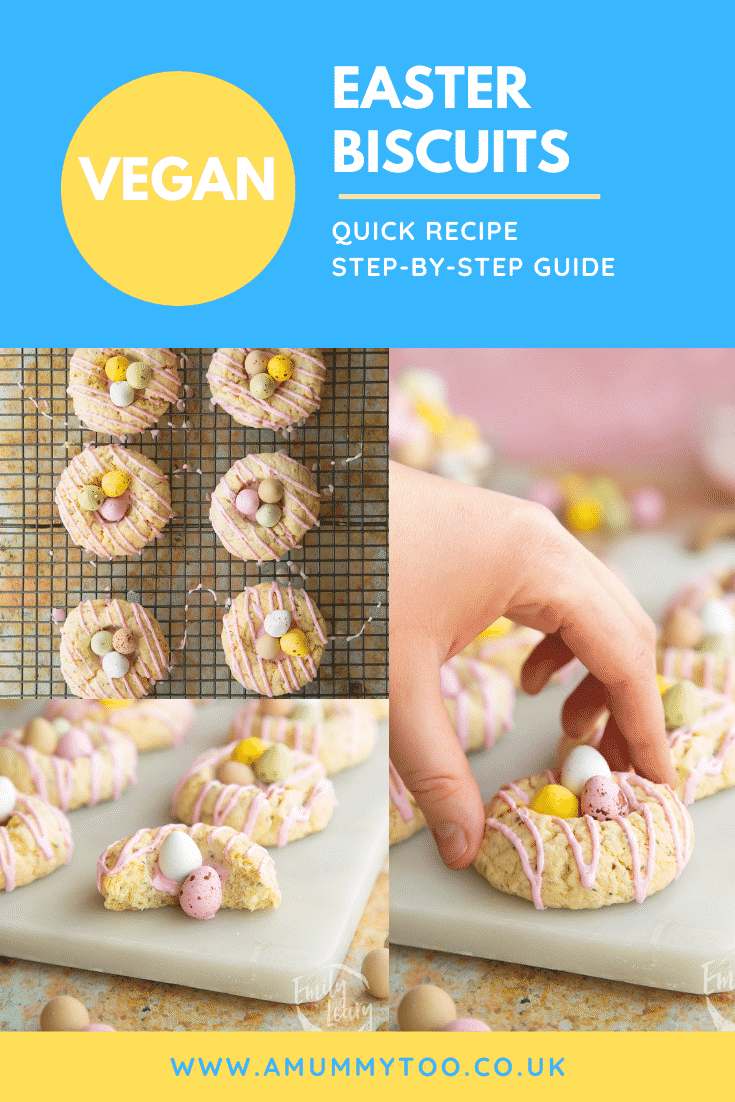


Anne Murdock says
I use a gluten free flour
Better batter ..that already has xanthum gum in it.
Ok?
Thanks
Emily Leary says
I haven't tested it so I cannot guarantee but that sounds like it should work, yes.